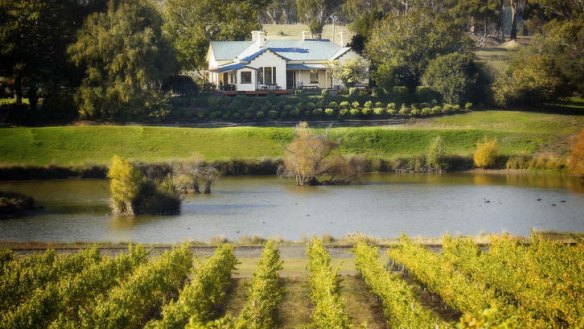A chardonnay with the X factor
Despite splitting opinions, there's no denying this Tasmanian superstar is big on character.

The Tasmanian chardonnay that beat the world's best in the recent Decanter World Wine Awards in London is a ''love it or hate it'' wine. ''My two offsiders at the winery both hate it,'' says the winemaker, Jeremy Dineen. ''And a colleague from South Australia dining in our restaurant recently sent it back!''
In competitions, it either wins a gold medal or is given a low score befitting a faulty wine.
The wine, Josef Chromy Chardonnay 2011, a $33 offering from the Relbia region near Launceston, won the International Chardonnay Trophy for the best chardonnay over £15, against the best that Burgundy and all the world's other great chardonnay regions could throw at it. On its way to the top award, it won the trophy for best Australian chardonnay. ''It's a very divisive wine,'' Dineen says. ''I quite like it, but I'm a bit bemused that it's done so well.''
The Chromy chardonnay is one of six international trophy winners that gave Australia its best-ever result at the Decanter awards this year. The others are Eden Springs High Eden Riesling 2008 - best riesling over £15; McGuigan Bin 9000 Hunter Valley Semillon 2007 - best white single varietal under £15; Penfolds Bin 389 Cabernet Shiraz 2010 - best red blend over £15; Credaro Beach Head Margaret River Shiraz 2011 - best red Rhone varietal over £15; and Campbells Rutherglen Topaque - best sweet fortified under £15.
These are great results, but the chardonnay, shiraz and riesling are standouts because they won highly competitive classes. And the fact they are in effect ''open'' classes, for wines more than £15, means there is no quality ceiling imposed by price.
Dineen says the Josef Chromy chardonnay went from being one of the winery's slowest-selling wines to its fastest seller in a heartbeat. It had sold out by the time the international trophy was announced, on September 4, because word had already spread that it had won the Australian regional trophy. It had also won a regional trophy at another monster wine show, the International Wine Challenge.
So, what is it about this chardonnay that makes it so controversial?
When asked to explain, Dineen cheerfully describes the wine's ''complex sulfide characters'', which make it smell and taste (in his words) like anchovies or crushed walnuts. The aroma is similar to that found in some of Burgundy's greatest chardonnays, such as Coche-Dury and Ramonet. ''It's a love-or-hate thing. [When colleagues complain], I just put my foot down and say, 'This is what we're doing anyway!''' Luckily, his boss, the Tassie wine veteran Joe Chromy, likes it.
The way Dineen achieves this complexity is via full-solids fermentation with a proportion of wild yeast ferments. ''I'm looking to build texture into the palate with the grape solids.'' Leaving the juice unclarified, with all the natural grape solids suspended in it, achieves this end. Of course, nobody can make great wine unless the grapes are of outstanding quality in the first place, as Chromy's obviously are. The sulfides are really just the patina on the sculpture. The other secret is that Dineen chooses to stop the wine taking the normal Burgundy step of undergoing a secondary or malolactic fermentation, which softens the acidity. The resulting wine has higher natural acidity.
We might ask why - if this is such a divisive wine - it's achieved so much show success … multiple trophies at two international competitions judged in England, plus a gold medal at last year's Adelaide Wine Show.
The answer must be that the judges who rated this wine highly were consciously looking for character, not just quality. This is a comparatively recent trend in wine shows. It is impossible to imagine this wine winning such awards just a few years ago. Now, the world is full of high-quality, well-made wines, but - arguably - there are too many same-ish chardonnays. Character, as well as quality, is becoming more prized, and actively sought.
The Decanter show is an enormous wine-judging event, possibly the world's biggest, with more than 14,000 entries this year. Dineen sighted the short-list of regional trophy chardonnays beaten by the Chromy. ''It's pretty good company to be in.''
Typically generous, Dineen points out three Tasmanian wines were short-listed for the 32 international trophies awarded on September 4. They were Bay of Fires 2011 pinot noir, Heemskerk 2008 sparkling wine, and his own wine.
South Australian Michael Hill Smith is co-chairman of the Australian judging panel and, although he was not involved in the international trophy taste-offs, he was full of praise. ''I think it's marvellous that those Australian wines negotiated that rather wiggly road through the initial judgings and then the trophy judgings, and got there,'' Hill Smith says. ''There was a lot of debate about the Chromy wine at the gold-medal stage, and I know it caused a lot of debate at the trophy judging too. It's a very funky wine, with a lot of those Coche-Dury-type complexities, which can be controversial.''
Decanter panel's tasting note
Wow! Exotic bouquet with lovely matchstick and mineral notes, great nutty complexity, and ripe apple following to a stylish, elegant and tightly structured palate. Toasty undertones, juicy lees and wild, lovely mineral freshness and intense fruit quality.
This Josef Chromy wine competed against other regional chardonnay trophy wines, including the top white burgundy — Philippe Colin Chassagne-Montrachet 1er cru Les Chaumees 2011. Two South African and one New Zealand chardonnay were also regional trophy winners.
You would have to trawl through all of the entries to discover what other white burgundies and Aussie chardonnays were in the show, but it's probably safe to say the likes of Bonneau du Martray, Domaine de la Romanee Conti, Coche-Dury and Comtes Lafon weren't there. Indeed, the greatest domaines of Burgundy and top growths of Bordeaux never enter wine competitions.
